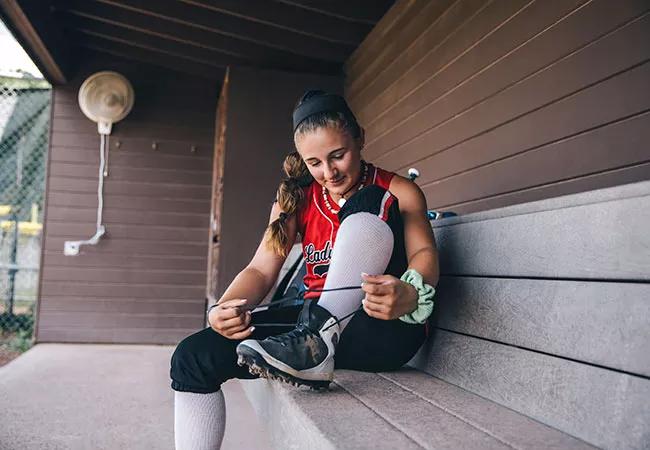Risk-based screening for cardiac injury and shared decision-making are key

As children seek to return to play following symptomatic COVID-19 infection, the risk of major adverse event – including sudden cardiac death – has become a significant source of fear for families.
Advertisement
Cleveland Clinic is a non-profit academic medical center. Advertising on our site helps support our mission. We do not endorse non-Cleveland Clinic products or services. Policy
Although a lot remains unknown about the longer-term effects of COVID-19 infection and COVID-19 related myocarditis has not been well established in athletes, current recommendations suggest that at-risk athletes should undergo cardiac screening prior to returning to play. However, there is no perfect screening mechanism for athletes with potential subclinical myocarditis, says pediatric cardiologist Ben Hammond, MD. Dr. Hammond and colleagues recently published a review on the importance of shared decision-making in cases in which such screening is inconclusive.
Myocarditis is a known risk factor for sudden cardiac death in athletes. Cardiac injury is common but variable in hospitalized adult patients with severe COVID-19 infection. That said, the majority of cardiac complications have been in adult patients with comorbidities, with very few reports of myocarditis in pediatric patients.
When thinking about return to play, Dr. Hammond and his pediatric cardiology colleagues recommend risk-based screening. Risk is determined primarily by severity of COVID-19 symptoms. Asymptomatic children and children who develop mild COVID-19 symptoms should be instructed to rest, with no exercise for 10 days from testing or from symptom onset. Schools generally require physician screening for all competitive athletes returning to play after COVID-19 regardless of symptoms severity.
Children who develop moderate symptoms of COVID-19 who are not hospitalized should follow self-isolation guidelines set by the U.S. Centers for Disease Control and Prevention. Children with moderate (no hospitalization required) to severe symptoms (hospitalized) should follow-up with their primary care pediatrician and potentially with a pediatric cardiologist following symptom resolution. Physicians recommended that these children rest without exercise for 10 to 14 days after symptom resolution before return to play is considered.
Advertisement
Formal cardiovascular risk stratification with appropriate screening should be considered for patients with moderate to severe COVID-19 symptoms. “We’ve been screening with ECG first, and then an echocardiogram if we have a suspicion by history or if the ECG is abnormal,” Dr. Hammond says. Screening with high sensitivity troponins is done routinely in adult patients and has been used in some older adolescent patients as well. Cardiac MRI may be considered in the presence of other abnormal testing. “Screening can result in ambiguous test results with uncertain clinical implications, including mild elevations in high-sensitivity cardiac troponin (hsTn), abnormal ECG findings, low-normal ventricular function by echocardiogram, and mild evidence of myocardial inflammation on cardiac MRI.”
According to Dr. Hammond, getting an accurate history is the most important aspect of screening in patients who have had COVID-19. “The physical exam won’t tell you everything,” he says. “We want to see that even though these athletes may feel behind with their conditioning, they are improving. If they are progressing and moving forward, I’m generally ready to consider return to play.”
“The patients I’m most concerned about are those that return to sports and feel increasingly unwell, experiencing chest pain with exertion or syncope. These patients should consult a pediatric cardiologist before resuming play.”
Regardless of symptom severity, symptomatic patients should ease into return to play following the recommended convalescence, with a graded resumption of activity under close supervision of athletic trainers, parents and pediatricians.
Advertisement
“Even before COVID-19, sudden cardiac arrest was rare in children – but it certainly does happen,” says Peter Aziz, MD, Director of Pediatric Electrophysiology at Cleveland Clinic Children’s. “In those circumstances, just about the only thing that may save the child’s life is an automated external defibrillator (AED). Public awareness and the availability of AEDs may be a more effective strategy than screening, as identifying all children at risk is not possible. In cases of witnessed sudden cardiac arrest, cardiopulmonary resuscitation should begin promptly, followed by AED application as soon as it is available, with immediate CPR resumption.”
The decision to return to play requires shared decision-making. Dr. Hammond describes shared decision-making in pediatric cardiology as a process that involves the patient, their parents, their team and their coaches.
“If the patient has recovered from COVID-19 and we’re considering return to play, I explain that the risk is low, but that doesn’t mean there is no risk.”
“We try not to be overprotective in our athletes, but engage them in a discussion of their risks to allow informed and safe participation. This is a process that is widely accepted in adults and increasingly so in youth, but we need to have some idea of their level of understanding and whether or not we think they will cooperate with a return to play plan.”
“If the patient and family appear cooperative, we discuss the importance of having an AED at every practice and every competition. This is important for every athlete given the unknown risks of all participants competing. It is very important for an athlete to listen to their body once they return to play, and to stop playing if they experience symptoms,” Dr. Hammond continues. “Physicians also need to be able to accept the risks involved, and should follow-up – perhaps by phone – as frequently as they need to feel comfortable with the shared decision.”
Advertisement
Advertisement

Patients report improved sense of smell and taste

Clinicians who are accustomed to uncertainty can do well by patients

Unique skin changes can occur after infection or vaccine

Cleveland Clinic analysis suggests that obtaining care for the virus might reveal a previously undiagnosed condition

As the pandemic evolves, rheumatologists must continue to be mindful of most vulnerable patients

Early results suggest positive outcomes from COVID-19 PrEP treatment

Could the virus have caused the condition or triggered previously undiagnosed disease?

Five categories of cutaneous abnormalities are associated with COVID-19